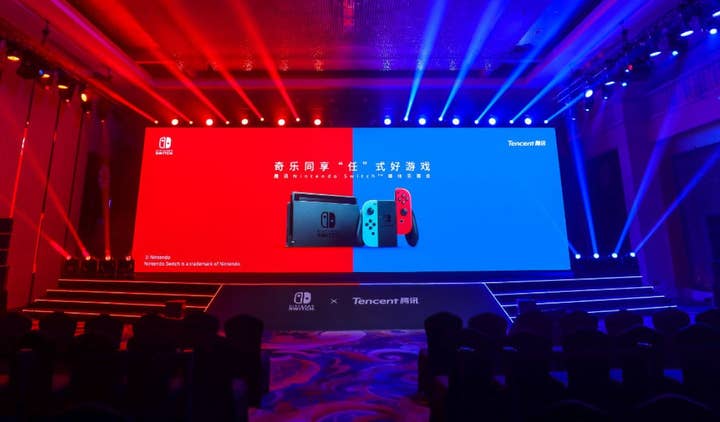Chinese Switch sales expose a failure to counter the import market | Opinion
Apptutti's Daniel Camilo on the ever-present import market in China, and why 1m Switch sales does not make Nintendo the market leader
On January 9, it was announced that the Chinese Nintendo Switch console has shipped at least one million units since its release back in December 10, 2019. The announcement came from Weide Hu, the director of Sales and Marketing for the Nintendo-Tencent cooperation.
Since these numbers were announced, a lot of reports have claimed that the Switch is the market leader for consoles in China. To say so is misleading and disingenuous at best, and fully false at worst (I'll get into that later). Also, to celebrate this milestone as a victory for Tencent and Nintendo is to ignore that, ultimately, most consumers in China actively rejected this version of the console and still prefer to buy imported models -- meaning the Nintendo Switch is popular in China, but the Tencent-backed Switch is not. It is a failure on the part of Tencent to effectively leverage and implement the Switch in the Chinese market.
Yes, this is a "cup half-empty" kind of piece; one that is not intended to be forcibly negative, but simply to lay down the cards on the table as they are, and to properly illuminate the full context of the situation.
Context about the Chinese console market
While all three major console makers have an official and legal presence in the Chinese market -- Sony with PlayStation 4, Microsoft's Xbox One/S/X, and Nintendo Switch -- the large majority of consoles actually sold and used in the country are imported. I addressed this dynamic when writing about common misconceptions people outside of China usually have about its market, and also regarding the availability of the PS5 and Xbox Series consoles. In practice, most consumers will buy their imported consoles from e-commerce platforms such as Taobao (the biggest in China) or, at a much smaller scale, directly from grey-market stores that can still be found in most major Chinese cities.
Most consumers in China actively rejected this version of the console and still prefer to buy imported models
The reason why gamers in China generally prefer imported consoles is two-fold: convenience and features. Consoles are available and easy to find online, prices match those commonly charged internationally, and courier delivery in China is usually extremely fast -- if ordering from a shop in the same city, it will likely arrive the next day, or even the same in some cases.
Most importantly, imported consoles are region-free, while the officially licensed Chinese models are riddled with restrictions, both physically and digitally. To be perfectly honest, even being based in China, it gets hard to keep track of updates and changes (if any) for restrictions in the functionality of consoles. What is certain is that all three have restrictions, to different degrees.
In the case of the Chinese Switch, the Nintendo eShop only includes games that have a publishing license (ISBN) for China. The current number of available games is extremely small, and only 13 games were approved during the entire year of 2020. International cartridges are compatible with the Chinese Switch, but online functions will either be restricted or fully disabled in many cases.
For most consumers who are even superficially informed about the consoles, buying a national model simply does not make any sense. There are no advantages at all, except perhaps when it comes to warranty and customer service. Imported models work perfectly well in the country, and imported games can be as easily acquired as the consoles themselves.
How many consoles are sold in China?
That's the big question that, really, nobody can answer. Considering that most consoles sold in China are imported models -- from Hong Kong, Japan, the US and other regions -- sales for those models are attributed to their market of origin. Tracking how many are present in China at any given moment would be practically impossible, unless someone/something could consistently monitor all units available in the thousands of online and physical sellers throughout the country.

That's for imports. For the officially licensed models, it's easier to get an idea. Back in 2018, during a ChinaJoy press conference, Sony revealed that the PS4 had sold more than 1.5 million units since its launch in the country in 2015. I have it from reliable sources that the current number is somewhere marginally above 2 million units. Not unlike in the rest of the world, Microsoft does not currently discloses sales numbers for its consoles, but we can safely assume the install base of the Xbox One in China is substantially smaller than that of the PS4.
As for the Chinese Switch, we now know it shipped 1 million units in roughly a year. However, I estimate the imports vastly outsell the national model launched by the cooperation formed between Tencent and Nintendo.
Who is the console market leader in China?
Going back to my initial claims of misleading reports, and taking into account all I just wrote, I would say Sony is still the undisputed console leader in China with the PS4. The only way one could claim the Chinese Switch is the leader is if we count the Switch as a gen-9 console (Xbox Series, PS5), which it technically is (the Wii-U was gen-8, with the Xbox One and PS4), and if we are accounting for the leader of the current generation of consoles only. In that case, the Chinese Switch is the winner by default, as both the PS5 and Xbox Series X/S are not yet available/licensed for sale in China.
If we are looking for the modern console with the larger install base in China, then all verifiable numbers suggest the PS4 rests on top. Plus, if we consider imported models, I would still assume the PS4 is also the leader, as the console has been consistently popular in China since its international debut, four years before the Switch launched.
Tencent's failure to leverage the Chinese Switch
While one million units sold of the Chinese Switch during 2020 (plus a few days during 2019) may look like a good figure, I believe it's safe to assume the number of imported models sold considerably more during the same period -- on a ratio of at the very least least three-to-one in the country. Back in early 2020, when the latest Animal Crossing game became a cultural phenomenon, many Chinese gamers were willing to pay double the price for an imported Switch instead of the national model, as reported at the time.
If we are looking for the modern console with the larger install base in China, all verifiable numbers suggest the PS4 rests on top
What I'm saying is, the Chinese Switch has never been a particularly popular consumer product in China. Tencent and Nintendo might spin the sales numbers as favorably as they can, and a lot of media will report it at face value, but once we really look at the big picture -- at the numbers and the potential -- success is not the result we have here.
China currently boasts a middle class of more than 700 million people, more than double the entire population of the US. Most of these 700 million people live in cities. We're talking about a mostly urban population with access to goods and services. While the purchasing power of the Chinese middle class still doesn't reach the heights of the equivalent in North America, it's important to understand that a product like Nintendo Switch (sold at aproximately 2000 Yuan, or $300 USD) is far from an inaccessible luxury item in China. Just to give a recent commercial example for reference, the new Xiaomi 11 smartphone sold over 350,000 units in five minutes when made available in the market. That was all the stock available at launch, for a $600 device.
It's true that there is a diminished "console culture" in China, when compared to mature markets like Japan, the US and most developed ones in Europe. One of the main reasons for this was the console ban in the country between 2000 and 2015. This was also the period when broadband internet and smartphones came to prominence. Mobile and PC gaming became the dominant platforms in China, and once the ban was lifted, consoles were a niche in the country.
A niche with potential, however, and one that could still move millions of units through the aforementioned import models.
Why did it fail?
When Tencent and Nintendo announced the Chinese Switch would launch in December 2019, it was almost three years after its international debut. It was launching with much less content (games and online services) available than anywhere else, and it was launching at approximately the same price as in other major markets. This is where Tencent failed -- and I'm emphasizing Tencent as they are the de-facto drivers of the Switch operation in China -- as it gave no good reason for consumers to buy the Chinese Switch.
One million units is indicative of failure... Most gamers in China saw the Chinese Switch for what it is, and decided not to buy it
In fact, it created a product that was/is not only redundant, but actually poor in comparison to what was already available in practice. In other words, it was dead on arrival. One million units is indicative of failure, not of success. Most gamers in China saw the Chinese Switch for what it is, and decided not to buy it. Considering the social and economic context, one million units is residual and marginal. The Sega Master System sold more units in Brazil alone.
A video game console, more than most other electronic devices, owes its success (or lack thereof) to its content: the games. For the Chinese Switch, the lack of games was always a predictable issue, and that is unlikely to change. Due to strict regulations, most popular games are unable to obtain a publishing license for China, and therefore all officially launched consoles in China won't stand a chance against the charm of imported models, as long as they're easily available.
Silver lining
One could argue that while core gamers in China were and are well aware that buying an imported Switch is a better choice, Tencent did manage to broaden the awareness of consoles in the country. Many, if not most, of the people who bought those one million units are likely those who were exposed to the many marketing campaigns promoting the console during the last year. Many of those consumers wouldn't even be aware of the console to begin with, and bought it either unaware or not caring about its intrinsic limitations. Then again, a lot of consumers who were exposed to the marketing for the Chinese Switch probably looked up some information online and ended up buying an imported model.
The silver lining is that the market is growing. The presence of consoles in China is growing. The market is still vastly dominated by mobile, but consoles are here and they have made their claim. Still, going back to the cup half-empty perspective... Content is king. Games matter.
It's unlikely that regulations for approval will loosen up anytime soon in China. Considering that, and understanding that most AAA and popular games won't stand a chance of being officially published for nationally licensed consoles, the ceiling for growth for these machines will remain extremely low in the foreseeable future.
Daniel Camilo lives in Shenzhen. He is the overseas business developer for Apptutti, a specialist in publishing games in China.
